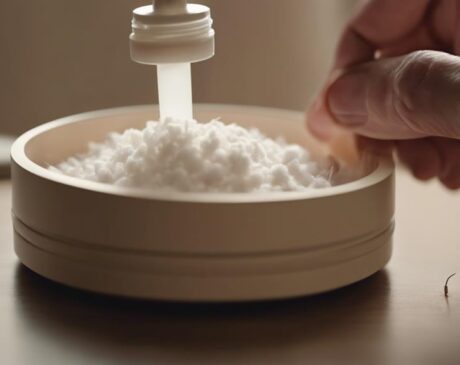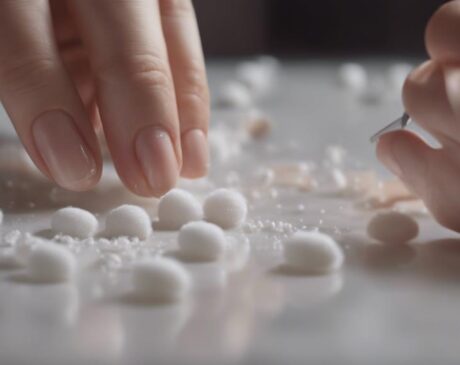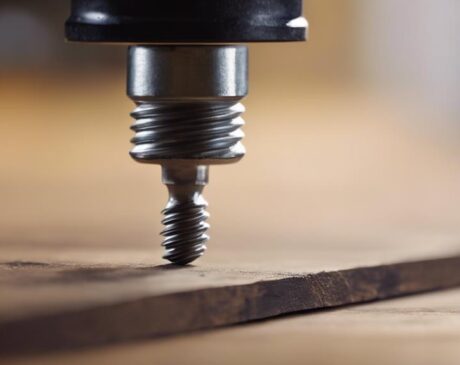Can I Use Superglue for Fake Nails?
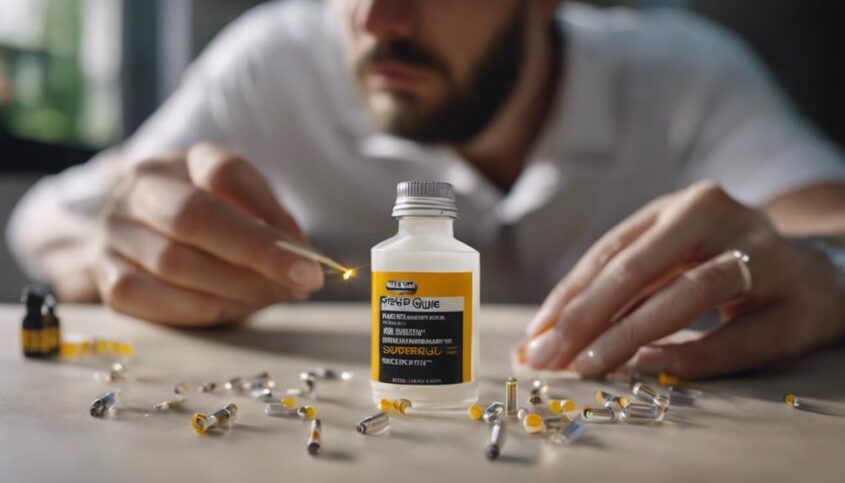
You can use superglue for fake nails for quick fixes and strong bonding. Ensure clean, dry nails for proper application. Avoid skin contact and ventilate well. Use minimal glue to prevent damage. Remember, safety first.
Key Takeaways
- Prioritize safety with clean, dry nails and minimal glue usage to prevent damage.
- Superglue offers strong bonding for quick fixes, but traditional nail glue may provide more durability.
- Improper use can weaken natural nails, so apply a thin layer only on fake nails.
- Ensure ventilation to avoid inhaling fumes, which can cause irritation and health issues.
- Consider alternative options like press-on nails or nail stickers for hassle-free application and removal.
Safety Considerations of Using Superglue
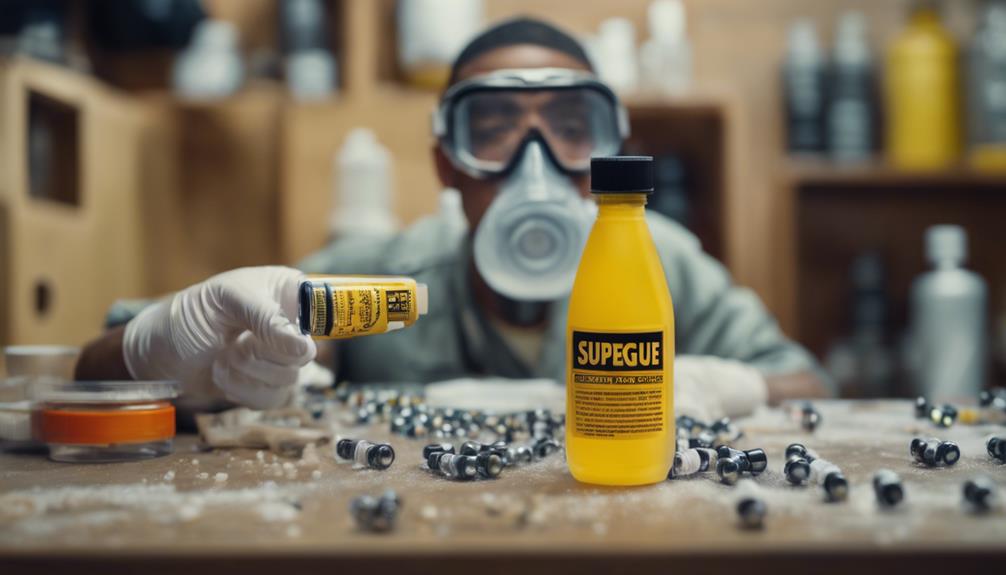
When using superglue for fake nails, always prioritize safety by following proper application techniques.
Start by ensuring your nails are clean and dry before applying the glue. Avoid getting the glue on your skin as it can cause irritation or bonding to your skin.
Ventilate the area well to prevent inhaling fumes. Be cautious of using too much glue, as excess glue can seep into the nail bed and cause damage.
If you experience any adverse reactions, such as redness or swelling, remove the fake nails immediately and seek medical advice if needed.
Effectiveness Comparison to Traditional Nail Glue
Considering the effectiveness of superglue for fake nails in comparison to traditional nail glue, it's important to evaluate their adhesive strength and longevity. Superglue, known for its strong bonding capabilities, can be a quick fix for attaching fake nails. However, traditional nail glue, specifically formulated for nail applications, may provide a more durable and long-lasting hold. While superglue can work in a pinch, it may not withstand daily activities as well as traditional nail glue.
Traditional nail glue is designed to be gentle on your natural nails while still keeping fake nails securely in place. It offers a balance between strength and flexibility, allowing for comfortable wear without compromising the health of your nails. On the other hand, superglue, although strong, may not provide the same level of protection and care for your natural nails.
When deciding between the two options, consider how long you want your fake nails to last and the level of activity your hands typically endure. Ultimately, the choice between superglue and traditional nail glue depends on your preferences and lifestyle.
Potential Damage to Natural Nails
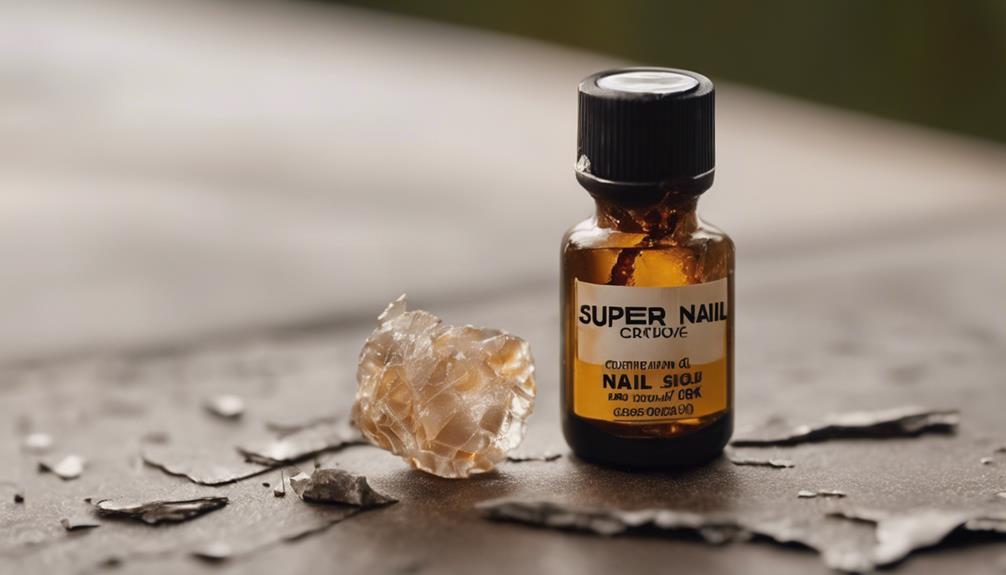
Superglue for fake nails can potentially cause damage to your natural nails if not used carefully and correctly. Using superglue improperly may lead to nail weakening, brittleness, and even breakage. The harsh chemicals in superglue can strip your nails of essential oils and moisture, leaving them dry and prone to splitting. Additionally, if the glue is applied too close to the cuticle or skin, it can cause irritation and potential allergic reactions.
To prevent damage to your natural nails when using superglue for fake nails, it's crucial to apply a thin layer of glue only to the fake nail and avoid contact with your natural nails or skin. Take care not to use too much glue, as excess can seep onto your natural nails and lead to adverse effects. Should you notice any signs of damage or irritation, remove the fake nails immediately and give your natural nails a break to recover. Remember, your natural nails deserve to be treated gently and with care.
Application Tips for Using Superglue
To ensure successful application when using superglue for fake nails, focus on precise placement and minimal glue usage to avoid potential damage to your natural nails. Start by applying a small amount of superglue directly onto the fake nail tip, then gently press it onto your natural nail. Make sure to align it with your cuticle for a natural look. Hold the fake nail in place for about 10-15 seconds to allow the glue to set.
Avoid using too much glue as excess can seep onto your skin or cuticles, causing irritation. If you accidentally get glue on your skin, wipe it off immediately with acetone. For a secure hold, apply pressure evenly across the entire nail. Once all nails are applied, wait a few minutes before filing or shaping them. Remember, less is more when it comes to superglue application for fake nails.
Removal Process and Risks Involved
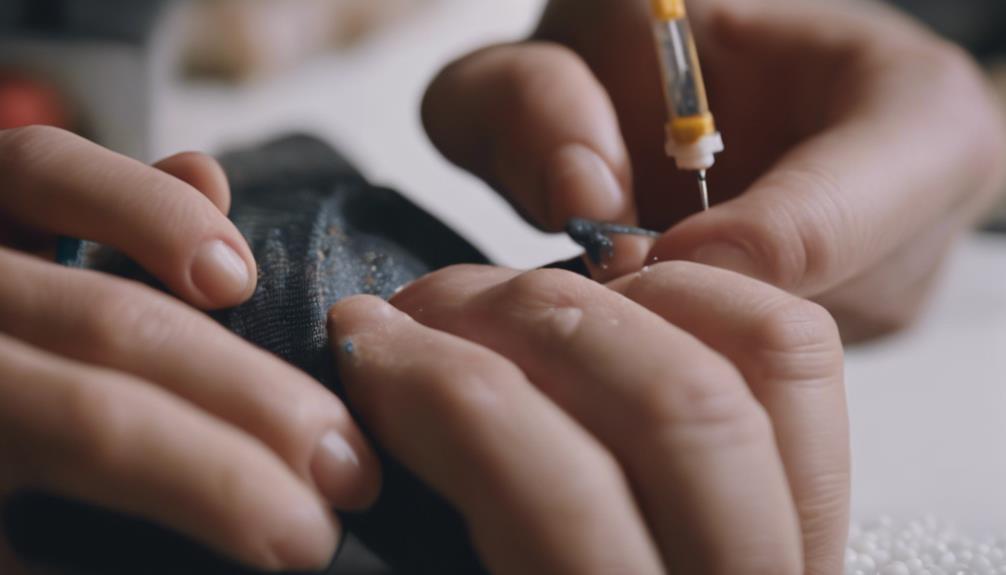
When removing fake nails attached with superglue, take precautions to minimize potential risks to your natural nails and skin. Begin by soaking your nails in warm, soapy water to help loosen the adhesive. Gently wiggle the fake nails to see if they start coming off easily. Avoid forcefully pulling them, as this can damage your natural nails. If the nails don't come off easily, soak them for a bit longer.
You can also use a nail buffer to gently file off the top layer of the fake nails, which can make them easier to remove.
Be cautious when using acetone to dissolve the superglue. While effective, acetone can be harsh on your skin and nails. Apply acetone to a cotton ball and place it on top of the nail, wrapping it in foil to hold it in place. Leave it on for about 15-20 minutes before gently removing the fake nails.
Moisturize your nails and hands after removal to prevent dryness and damage. By taking these precautions, you can safely remove fake nails attached with superglue without harming your natural nails and skin.
Longevity and Durability of Superglue
To understand the longevity and durability of superglue when used for fake nails, consider how these factors impact the overall wear and tear on your natural nails during the removal process. Here are some key points to keep in mind:
- Adhesion Strength: Superglue is known for its strong bonding capabilities, which can lead to longer-lasting fake nails. However, this same strength can also make removal more challenging and potentially damaging to your natural nails if not done carefully.
- Resistance to Water and Wear: Superglue can withstand exposure to water and daily activities better than some traditional nail glues, providing a more durable option for those with an active lifestyle.
- Maintenance: While superglue may offer extended wear time, it's essential to regularly check the integrity of your fake nails and address any lifting or damage promptly to prevent further issues.
Cost Comparison With Nail Glue Products
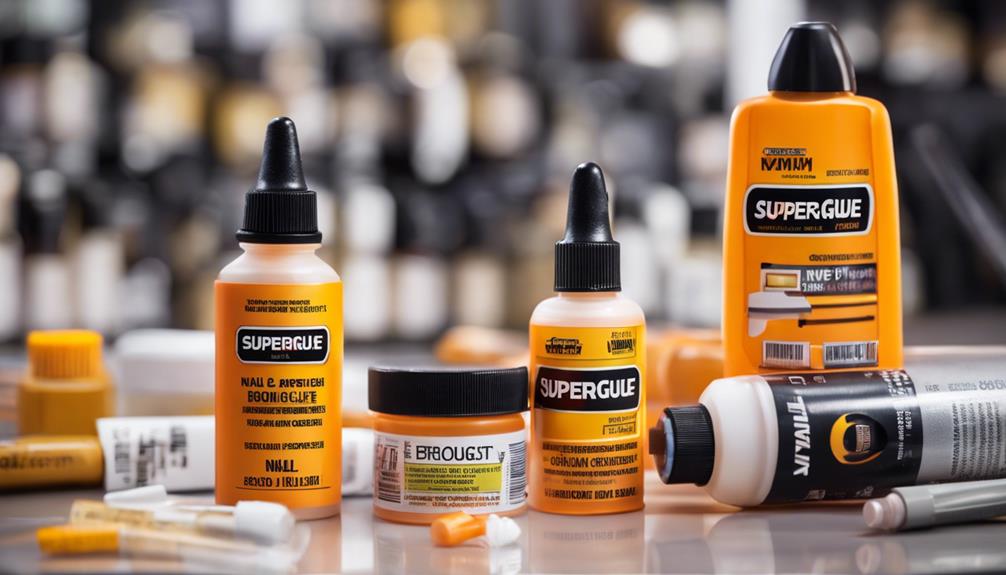
When comparing the cost of using superglue versus nail glue products, you'll find a significant difference in pricing.
The longevity and durability of superglue for fake nails can also impact the overall cost-effectiveness of this alternative.
Consider these factors carefully to make an informed decision on which option best suits your budget and needs.
Cost of Superglue Vs. Nail Glue
Comparing the cost of using superglue versus traditional nail glue products can help you make an informed decision for your fake nail application. When considering the cost, keep in mind the following:
- Initial Investment: Superglue is generally more cost-effective upfront compared to nail glue products.
- Long-Term Expenses: Nail glue products may last longer and require fewer reapplications, potentially saving you money over time.
- Quality Consideration: While superglue can be cheaper, nail glue products are specifically formulated for fake nails, ensuring better adhesion and less damage to your natural nails.
Consider these factors when deciding between superglue and nail glue products for your fake nails.
Longevity and Durability
For maximum longevity and durability, opt for nail glue products over superglue when applying your fake nails. While superglue may seem like a quick fix, it lacks the specific formulation designed for fake nails, leading to a shorter wear time.
Nail glue products are tailored to provide a strong bond that can withstand daily activities, ensuring your fake nails stay in place for longer periods. Although nail glue products may have a slightly higher cost compared to superglue, the investment pays off in the extended wear you'll experience.
Health Risks Associated With Superglue Use
Using superglue for fake nails can lead to potential skin irritation and exposure to toxic fumes.
It's important to be cautious when using superglue as it can cause adverse health effects if not handled properly.
Take necessary precautions to safeguard your health when using superglue for fake nails.
Potential Skin Irritation
Potential skin irritation can occur when using superglue for fake nails. To minimize these risks and ensure a safe experience, follow these tips:
- Avoid skin contact: Keep the superglue away from your skin as much as possible.
- Use a small amount: Apply a thin layer of glue to reduce the chances of skin irritation.
- Remove excess glue: Wipe off any excess glue quickly to prevent it from coming into contact with your skin.
Toxic Fume Exposure
Exposure to toxic fumes from superglue can pose serious health risks when using it for fake nails. When you apply superglue for fake nails, the fumes released contain chemicals like cyanoacrylate that can irritate your eyes, nose, and throat.
Inhaling these fumes in enclosed spaces can lead to dizziness, headaches, and even nausea. Prolonged exposure may cause respiratory issues and allergic reactions.
To minimize the risk of toxic fume exposure, ensure proper ventilation in the area where you're using superglue. Consider using a respirator mask to protect yourself from inhaling the fumes.
Prioritize your health and well-being by being mindful of the potential dangers associated with superglue fumes when applying fake nails.
Alternative Options for Fake Nail Application
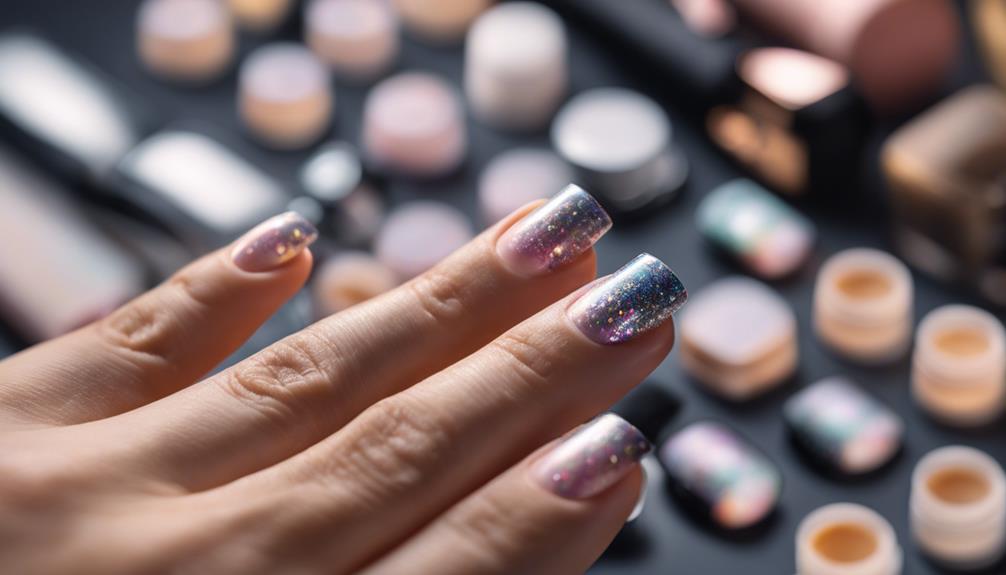
Consider trying other methods to apply fake nails for a versatile and convenient experience. Instead of relying solely on superglue, explore these alternative options:
- Press-On Nails: Opt for press-on nails that come with adhesive tabs pre-applied. They're easy to use, require no drying time, and can be quickly removed without damaging your natural nails.
- Nail Stickers: Experiment with nail stickers that can be easily applied to your nails for a temporary and hassle-free fake nail look. They come in various designs and colors, offering a fun and customizable nail art experience.
- Nail Wraps: Try nail wraps as a simple alternative to traditional fake nails. These thin adhesive sheets can be trimmed to fit your nails and come in a wide range of patterns, allowing you to achieve a professional-looking manicure at home with ease.
Exploring these alternative methods can provide you with the freedom to switch up your nail look regularly without the commitment or potential risks associated with using superglue.
Frequently Asked Questions
Can Superglue Be Used to Fix Broken Fake Nails?
When fixing broken fake nails, superglue can be a quick solution. It's not ideal for long-term use as it may damage your natural nails. Remember to apply it carefully and sparingly for temporary repairs.
Will Using Superglue on Fake Nails Affect the Nail Polish or Nail Art on Top?
When you use superglue on fake nails, it can seep through and mess up the nail polish or art above. So, be cautious when fixing those nails or you might end up with a sticky situation.
How Long Should I Wait Before Applying Superglue to My Fake Nails After Removing Them?
Before applying superglue to fake nails after removal, wait at least 24 hours for optimal adhesion. Rushing may result in weaker bonds. Allow proper drying time to ensure the longevity of your faux nail application.
Can Superglue Be Used to Reapply Fake Nails That Have Fallen Off?
When reapplying fake nails that have fallen off, using superglue can be an option. It's like patching up a small tear in your favorite jeans. Just be cautious to avoid skin contact.
Are There Any Specific Brands or Types of Superglue That Are Recommended for Use With Fake Nails?
For attaching fake nails, some brands like KISS Maximum Speed Nail Glue and IBD Brush-On Nail Glue are popular choices. Look for products specifically designed for nail application to ensure a strong and lasting bond.

